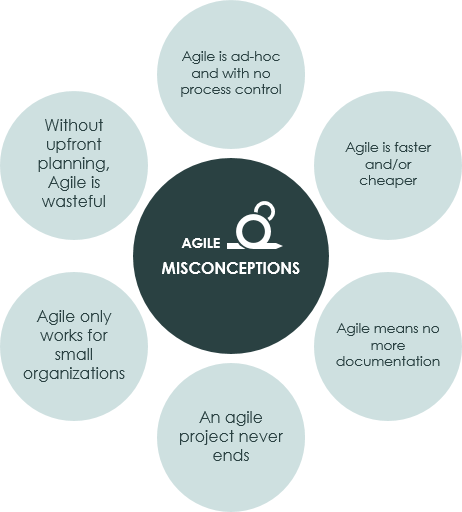Top 6 Common Misconceptions in Agile Development
Over the past decade, agile software development is a hot topic of discussion for many businesses, replacing the traditional waterfall model. There are some misconceptions about agile development in spite of its popularity and success. This article will examine some of the common misconceptions about agile approach. Here are 6 common misconceptions about agile software development we are often encountered:

- Agile is ad hoc, with no process control: First of all, Agile isn’t a lack of process. Agile provides a range of formal processes, and methods, to inform work processes, customer engagement and management models. Conversely, Agile isn’t about blindly following the prescribed ‘agile’ methods and processes. Agile is about using your common sense to apply processes, as determined by the current situation, and shaped by the agile philosophy.
- Agile is faster and/or cheaper: Agile isn’t significantly faster, or cheaper, than alternative frameworks. Put another way, in most cases you can’t get significantly more effort out of your Teams by moving to an agile approach. While there is an overall efficiency gain when utilizing agile methods, well-managed Agile and non-Agile Teams will deliver products and services in approximately the same time and effort.
- Agile mean no more documentation: Agile is not an excuse to avoid appropriate planning or writing documentation. It is an on-demand, or Just-In-Time, approach that encourages continuous planning and documentation, but only when needed for specific Customer Requirements. This allows Customers and Teams to determine if the planning, or document, adds value to the process or product. It creates an opportunity to emphasize valuable documents, and eliminate anything that isn’t useful.
- An Agile project never ends: While this may be true in some situations, the benefit of Agile is that work will continue while the Customer continues to gain business value, and that value is worth more than the cost of developing it. Most projects, in any industry, have a point of diminishing returns. This is the ideal time for an agile project to end.
- Agile only works for small organizations: Agile works for projects, teams and organizations of any size, not just small projects. That is not to say that it will work for all organizations, but size is rarely a factor. Large and complex projects and organizations are often excellent candidates for Agile transformation, where it is difficult, or impossible, to know all your Customer’s Requirements in advance.
- Without upfront planning, Agile is wasteful: This assumes that your Customer knows the detail of all of their Requirements in advance. If this is true, then by all means, undertake comprehensive upfront planning. However, in reality this is rare, and usually leads to the greater ‘waste’ of having undertaken design and development work that was ultimately unnecessary. Agile Business Management encourages minimal upfront planning, ensuring everyone is working towards the same goal, and reduces the risk of miscommunication.

Ready for Agile?
Want an agile tool that can manage your scrum projects well? Visual Paradigm features a user story mapping tool, Affinity Estimation tool, sprint management tool, and task management.
Try it Free

